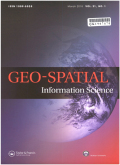- 钛学术文献服务平台 \
- 学术期刊 \
- 基础科学期刊 \
- 天文学、地球科学期刊 \
- 地球空间信息科学学报(英文版)期刊 \
A power-law-based approach to mapping COVID-19 cases in the United States
A power-law-based approach to mapping COVID-19 cases in the United States
基本信息来源于合作网站,原文需代理用户跳转至来源网站获取
摘要:
This paper examines the spatial and temporal distribution of all COVID-19 cases from January to June 2020 against the underlying distribution of population in the United States. It is found that, as time passes, COVID-19 cases become a power law with cutoff, resembling the underlying spatial distribution of populations. The power law implies that many states and counties have a low number of cases, while only a few highly populated states and counties have a high number of cases. To further differentiate patterns between the underlying populations and COVID-19 cases, we derived their inherent hierarchy or spatial heterogeneity characterized by the ht-index. We found that the ht-index of COVID-19 cases persistently approaches that of the populations; that is, 5 and 7 at the state and county levels, respectively. Mapping the ht-index of COVID-19 cases against that of populations shows that the pandemic is largely shaped by the underlying population with the R-square value between infection and population up to 0.82.

推荐文章
COVID-19临床资料分析
新型冠状病毒
感染
新型冠状病毒性肺炎
COVID-19疫情下方舱CT的紧急建设
新型冠状病毒肺炎
方舱CT
辐射防护
CT质量控制
儿童COVID-19的流行病学与临床诊疗特点
新型冠状病毒肺炎
儿童
流行病学
诊断治疗
COVID-19合并肺血栓栓塞症的临床特点
新型冠状病毒肺炎
新型冠状病毒
肺栓塞
预后
内容分析
关键词云
关键词热度
相关文献总数
(/次)
(/年)
文献信息
| 篇名 | A power-law-based approach to mapping COVID-19 cases in the United States | ||
| 来源期刊 | 地球空间信息科学学报(英文版) | 学科 | |
| 关键词 | |||
| 年,卷(期) | 2021,(3) | 所属期刊栏目 | |
| 研究方向 | 页码范围 | 333-339 | |
| 页数 | 7页 | 分类号 | |
| 字数 | 语种 | 英文 | |
| DOI | |||
五维指标
引文网络
引文网络
二级参考文献 (0)
共引文献 (0)
参考文献 (0)
节点文献
引证文献 (0)
同被引文献 (0)
二级引证文献 (0)
2021(0)
- 参考文献(0)
- 二级参考文献(0)
- 引证文献(0)
- 二级引证文献(0)
引文网络交叉学科
相关学者/机构
期刊影响力
地球空间信息科学学报(英文版)
主办单位:
武汉大学(原武汉测绘科技大学)
出版周期:
季刊
ISSN:
1009-5020
CN:
42-1610/P
开本:
16开
出版地:
武汉市珞瑜路129号武汉大学测绘校区
邮发代号:
创刊时间:
1998
语种:
eng
出版文献量(篇)
958
总下载数(次)
0
总被引数(次)
2719
期刊文献
相关文献
推荐文献
- 期刊分类
- 期刊(年)
- 期刊(期)
- 期刊推荐
力学
化学
地球物理学
地质学
基础科学综合
大学学报
天文学
天文学、地球科学
数学
气象学
海洋学
物理学
生物学
生物科学
自然地理学和测绘学
自然科学总论
自然科学理论与方法
资源科学
非线性科学与系统科学
地球空间信息科学学报(英文版)2022
地球空间信息科学学报(英文版)2021
地球空间信息科学学报(英文版)2020
地球空间信息科学学报(英文版)2019
地球空间信息科学学报(英文版)2018
地球空间信息科学学报(英文版)2017
地球空间信息科学学报(英文版)2016
地球空间信息科学学报(英文版)2015
地球空间信息科学学报(英文版)2014
地球空间信息科学学报(英文版)2013
地球空间信息科学学报(英文版)2012
地球空间信息科学学报(英文版)2011
地球空间信息科学学报(英文版)2010
地球空间信息科学学报(英文版)2009
地球空间信息科学学报(英文版)2008
地球空间信息科学学报(英文版)2007
地球空间信息科学学报(英文版)2006
地球空间信息科学学报(英文版)2005
地球空间信息科学学报(英文版)2004
地球空间信息科学学报(英文版)2003
地球空间信息科学学报(英文版)2002
地球空间信息科学学报(英文版)2001
地球空间信息科学学报(英文版)2000

 免费查重
免费查重










